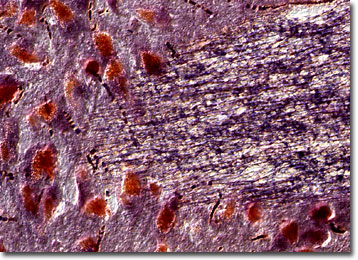Differential Interference Contrast Image Gallery
Human Cerebrum
Studies concerning the origin of intelligence have been ongoing for thousands of years, some ancient philosophers, such as Aristotle and Homer, believing that the intellect was seated in the heart. Major insight into the physiological workings of the brain, however, did not evolve until 1791 when Luigi Galvani demonstrated that electricity existed inside brain cells, a feat that inspired a tremendous outpouring of public interest, as well as Mary Shelley’s Frankenstein.

Modern science has revealed that the human brain is divided into several sections that work together to complete the complex functions of humans. The three primary regions of the brain are the brain stem, the cerebellum, and the cerebrum. The cerebrum is currently the largest part of the human brain, comprising approximately 85 percent of its total weight and weighing almost three pounds. The cerebrum of early man, however, was not as developed as it is today, encompassing only about a third of its current weight. Thus, as the composition of the brain has changed dramatically over the last 100,000 years, so have the mental processes of humans.
The cerebrum is generally believed to be the area of the brain in which all conscious mental activities transpire. Divided into two hemispheres by a deep groove called the longitudinal cerebral fissure, each side of the cerebrum is active in different tasks. The left hemisphere of the cerebrum is associated with reasoning, language, logic, and numbering. The right side, however, is associated with creativity and is important in activities such as facial recognition, depth perception, and orientation. The reason for this asymmetrical functionality of the cerebrum has been widely debated among scientists and was once solely believed to be a human trait. However, evidence of less pronounced symmetries has since been found in other animals.
